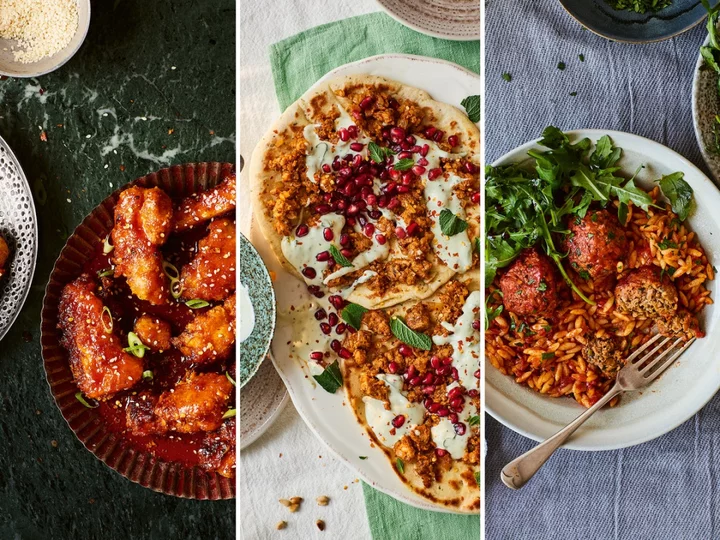
From tofu chicken wings to chickpea bacon – how and why you should be making plant-based meat at home
Turns out you can still eat meat without the carbon footprint – just make it plant-based. That’s the ethos behind Henry Firth and Ian Theasby’s new book. The duo behind the best-selling BOSH! series have released (dun, dun, dun...) Meat, which shows you how to cook delicious dishes that feel and taste like meat, but are in fact 100 per cent plant-based. After “giving veganism a whirl” for a month in 2015 (“before it was cool,” they add) – partly prompted by a desire to improve their health and partly after watching the eye-opening environmental documentary Cowspiracy – the pair made the switch permanent and launched BOSH. The rest, they say, is history – and it’s certainly a successful one. But going cold turkey (ahem) wasn’t all smooth sailing. “Initially, the main thing we missed was choice,” Theasby tells The Independent. Back in 2015, when he walked into a restaurant or a supermarket, there simply wasn’t much on offer. “In Pret, you’d get a hummus wrap if you were lucky. If you went to Tesco, you might get a really dry, crumbly falafel sandwich and that was it,” he says. But, fast forward eight years, “you walk into a supermarket today and it’s not what can I eat, but what shall I eat? Because there’s so much choice.” Theasby and Firth are the first to admit that even enduring vegans get cravings sometimes. In their new book, they say: that’s okay! Plants can be meat too. “If you think about a burger, it can made from an animal or it can be made from a plant. We accept that now,” says Firth. It might be strange to hear a vegan say that “we should celebrate meat” but “it’s got wonderful flavours, wonderful textures, but you can make it from plants, either from using vegetables or using some of those products that are now everywhere in the supermarket, which are pretty damn good.” The keyword is texture, says Theasby. “One thing that people lack when they first start eating plant-based is texture, so what we wanted to do was produce a book that was packed full of bite and chew so your mouth doesn’t miss anything when you first go plant-based. Some of the recipes in there you would not be able to guess are plant-based.” The recipes in Meat use a combination of meat alternative products and straight-up plants to achieve this. For example, there’s a section at the start that details how difficult it was to recreate bacon. Using a mix of chickepas and seitan (also known as vital wheat gluten), with flavourings like miso and colourings like beetroot, they create a kind of red and white dough that is rolled out, kneaded and cut into the shape of a piece of bacon. “It looks like bacon, it has the same mouthfeel as bacon, it’s got the same flavour profile as bacon,” says Theasby. “It’s a magic thing.” Don’t let that put you off, says Firth. “People do get a bit freaked out and they’re scared of ultra-processed stuff and of what’s in it. It’s good to read the label but it’s also good to not be scared by new things just because they’re new.” If you aren’t freaked out, however, we’ve got three sneakpeak recipes from the new book to put your mind at ease. Crispy Korean-style ‘chicken’ wings “These wings are SO crispy and delicious! Seriously, we love them. You can eat them as they come or you could push the boat out and serve them in a sandwich with a little plant-based mayo, kimchi and lettuce with a side of fries. They’d also go well with a side of rice and a little salad. Whichever way you choose, we’re pretty sure you’ll love them as much as we do.” Serves: 4-6 as a side Ingredients: For the sticky marinade: 4 garlic cloves 2.5cm piece of fresh ginger 150g gochujang 120ml toasted sesame oil 2 tbsp rice vinegar 2 tbsp light soy sauce 4 tbsp light brown sugar ¼ tsp ground white pepper For the ‘chicken’: 2 x 280g blocks extra-firm tofu 6 tbsp cornflour ½ tsp sea salt ¼ tsp ground white pepper Vegetable oil, for shallow frying For the garnish: 1 fresh chilli or a pinch of dried chilli flakes 1 spring onion A few toasted sesame seeds, for sprinkling Equipment: Fine grater or microplane Blender (optional) Frying pan Saucepan Method: Line a plate or large bowl with kitchen paper Make the marinade: Peel the garlic and ginger and grate with a tine grater or microplane. Combine with the rest of the ingredients and either blitz in a blender or combine in a bowl and stir into a nice smooth paste Prepare the chicken: Press the tofu to remove excess liquid. Tear the tofu into rough chunks about 3 x 2cm. Add the tofu to a mixing bowl along with half the marinade and fold to coat. Sprinkle the cornflour, salt and pepper into the bowl and fold to coat and combine, making sure the tofu is really well covered. Cook the chicken: Pour 1cm of oil into a frying pan and heat over a medium-high heat until the oil bubbles around the end of a wooden spoon that’s held in the oil. Carefully lower the tofu chunks into the hot oil and cook for 2-3 minutes until golden and crispy, turning them regularly to ensure a really even cook. Remove carefully and drain on a plate lined with kitchen paper. Finish the dish: Put the remaining marinade into a saucepan, bring to a simmer and cook until thick and shiny. Add the cooked tofu to the sauce and quickly fold it through to ensure a good coverage. Spoon the tofu into a serving bowl. Trim and thinly slice the spring onion for the garnish and finely chop the chilli (if using fresh chilli). Garnish the tofu with the chilli or chilli flakes, spring onion and toasted sesame seeds and serve immediately with some cold beers! Lebanese-style ‘lamb’ flatbreads with minty yoghurt “Making flatbread may feel like a labour of love but, really, it involves just a handful of cupboard ingredients and a few kneads to create delicious flatbreads that are impossibly soft on the inside with a glorious golden crust on the outside. You could serve them with anything, but we’ve stacked them high with a crumbled tempeh lamb spiced with mint, lemon and chilli, and drizzled them with a zesty mint yoghurt. “This recipe is good for 2, so if you need to serve 4 simply double everything. Deeeeelicious!” Serves: 2 Ingredients: For the flatbreads: 140g strong white bread flour, plus extra for dusting 1 tsp fast-action dried yeast 1 tsp caster sugar 1 tsp baking powder 1 tsp dried mixed herbs 1 tsp table salt 80ml lukewarm water 1 tbsp olive oil Plant-based butter, softened, for brushing For the ‘lamb’ topping: 300g tempeh 1 onion 2 garlic cloves splash of olive oil 1 tsp ground cumin ½ tsp ground coriander ½ tsp ground nutmeg 1 tsp smoked paprika 1 tsp chilli powder 2 tbsp mint jelly 1 lemon Sea salt For the mint yoghurt: A few fresh mint leaves 150g plain plant-based yoghurt 1 tbsp mint jelly 1 lemon Sea salt To serve: Handful of fresh mint leaves Handful of pomegranate seeds 1 tbsp toasted pine nuts Pinch of dried chilli flakes Black pepper Equipment: Large saucepan 2 large flat pans (or 1, and cook the flatbreads in batches) Pastry brush Method: Make the flatbread dough: In a large bowl, mix together the dry ingredients (the flour, yeast, sugar, baking powder, mixed herbs and salt) until there are no lumps. Pour in the lukewarm water and olive oil and bring the mixture together to form a dough ball (ensuring you incorporate every part of the mixture). Place the dough ball on a lightly floured surface and knead for 6-10 minutes until the ball bounces back when pressed. Place the ball back in the bowl, cover and leave somewhere warm for at least 30 minutes Make the lamb topping: Crumble the tempeh into small pieces using your hands. Peel and dice the onion and garlic. Place a large saucepan over a medium heat and add the olive oil. Add the diced onion, garlic and a pinch of salt. Mix well and cook for 5-10 minutes until the onion begins to soften. At this point, add the spices and crumbled tempeh with a dash of water. Mix well and cook for 5 minutes, then stir through the mint jelly. Halve the lemon and squeeze in some lemon juice, catching any pips in your free hand. Reduce the heat to low and cook for 10 minutes Make the mint yoghurt: Thinly slice the mint leaves. Put the yoghurt in a small bowl and mix through the mint jelly, sliced mint leaves and a pinch of salt. Halve the lemon and squeeze in some juice, catching any pips in your free hand. Spoon into a small serving bowl Cook the flatbread: Place 2 large flat pans over a medium heat (over separate flames). Take the flatbread mixture from the bowl and halve it. Place each piece on a lightly floured work surface and push down using your hands or a rolling pin to create a round, flatbread shape – it should be quite thin as it will become thicker in the pan. Once the pans are hot, add the flatbreads and cook for 2-3 minutes on each side until golden all over and cooked through. If you don’t have two flat pans, cook the flatbreads in one flat pan, one at a time. Assemble the flatbreads: Place the flatbreads on 2 serving plates and brush with some butter. Spoon the lamb mixture on top of the flatbreads then drizzle over some mint yoghurt. Time to serve: Chop some mint leaves and sprinkle them over the top of the flatbreads, along with a pinch of black pepper, the pomegranate seeds, pine nuts and chilli flakes (or your favourite toppings) Orzo ‘meat’-balls “Orzo – a type of pasta – is an ingredient we don’t use very often but when we do use it, we’re always left wondering why we don’t use it more often because it’s lovely. On the subject of lovely, the inspiration for this magnificent recipe came from the queen of cooking herself, Nigella Lawson.” Serves: 4 Ingredients: For the meatballs: 20g flat-leaf parsley (including the stalks) 3 garlic cloves 2 tbsp chia seeds 600g plant-based mince 3 tbsp panko breadcrumbs 4 tbsp nooch (nutritional yeast) or grated plantbased parmesan 2 tsp sea salt 2 tsp ground black pepper For the sauce: 1 small onion 20ml olive oil 1 tsp sea salt flakes 250ml plant-based white wine 2 x 400g tins chopped tomatoes 3 tbsp tomato puree 1 tsp paprika ½ tsp dried chilli flakes 1 tbsp red wine vinegar 1 tbsp light brown sugar 2 tbsp plant-based butter 285ml cold water 250g orzo pasta To serve: Handful of fresh parsley Sprinkle of nooch (nutritional yeast) or plant-based parmesan Small bag of fresh rocket Squeeze of lemon juice Equipment: Large heavy-based saucepan with lid Make the meatball mixture Finely chop the parsley and set aside Peel and finely chop the garlic Soak the chi a seeds in a bowl with 4 tablespoons of cold water for about 10 minutes until it forms a gel Ingredients: Place all the ingredients for the meatballs into a large bowl and mix together with your hands, being sure not to overmix, as it will make the meatballs dense-textured and heavy. Make the meatballs: Pinch out pieces of the mix and form them into walnutsize balls, putting them on a clean plate as you go. You should get about 20 meatballs. Make the sauce: Peel and finely dice the onion. Heat the oil in a heavybased saucepan that’s large enough to take the meatballs and pasta. Add the chopped onion with the salt and cook over a medium heat, stirring every now and again, for about 10 minutes until softened. Add the wine and simmer for a further 10 minutes. Add the tomatoes, tomato puree, paprika, chilli flakes, vinegar, brown sugar and butter. Fill both the empty tins with the water, give them a good swill, pour into the pan, bring the sauce to a simmer, put the lid on and cook for 30-35 minutes. Cook the meatballs: Drop the meatballs gently into the simmering sauce. Bring back to the boil, turn the heat down again to a simmer, put the lid back on and simmer the meatballs for 15 minutes. Add the pasta: Tip in the orzo, stir gently and increase the heat to bring the mixture back to a bubble. Simmer for 15 minutes, or until the pasta is cooked. You will have to stir it occasionally throughout this time to make sure the orzo isn’t sticking to the bottom of the pan. Time to serve: Chop the parsley (to serve). Spoon the pasta into bowls, sprinkle with parsley, nooch and a handful of rocket, add a squeeze of lemon juice and tuck in. ‘BOSH! MEAT’ by Henry Firth and Ian Theasby (HQ, HarperCollins). Read More The dish that defines me: Mallini Kannan’s baked honey-soy salmon Breakfast for dinner and four other things you should cook this week How to save money in the kitchen according to top chefs Money-saving chilli con carne that absolutely slaps with flavour How to pimp up your instant ramen (and save money) Do it for the Gram: Speedy but spectacular goat’s cheese linguine
2023-08-17 22:20

Exclusive-Tyson Foods plans to sell China poultry business -sources
By Kane Wu and Abigail Summerville HONG KONG/NEW YORK U.S. meat and processed food maker Tyson Foods plans
2023-08-17 13:54

Michelle Obama says she had the same thing for breakfast each day ‘for most of her life’
Michelle Obama has revealed that her palate is a little more straightforward than some may assume from a former first lady. Speaking on the first episode of Your Mama’s Kitchen, a podcast hosted by journalist Michele Norris and co-produced by the Obamas’ media company, Higher Ground, Michelle revealed she never really enjoyed eating breakfast. “I was kind of a picky eater,” she said. “I didn’t like any breakfast-anything. And my brother, who ate breakfast all the time, thought I was crazy.” Michelle continued: “We had big breakfasts because my brother, he was a growing athlete. So it was everything — cereal followed by scrambled or fried eggs followed by lots of toast and bacon and link sausage. So breakfast was big.” As a result, she explained that “everybody else in the whole household, on the whole planet, loved breakfast food except for [me] ... I despised breakfast.” Michelle revealed that she became “really stubborn” over her breakfast and decided to choose a different meal. “[I ate] peanut butter and jelly every morning until I went to college,” she said. “That was all I really liked. It was sort of a compromise that I made with my mother because it’s got peanuts, that’s protein, a little bit of oil. “Nothing’s wrong with bread if we’re having toast, why can’t I have it in a sandwich form and jelly? Everybody was having jelly on their toast.” She added that this would form her breakfast “every morning for most of [her] life”. However, nowadays, she is a fan of more wide-ranging breakfast foods. “I’m big into all of it now. Give me eggs benedict. Any eggs, any way,” she added. The admission comes after Michelle reflected on former US President Donald Trump’s Inauguration Day and revealed why she was sobbing after it. During the first episode of Michelle Obama: The Light Podcast, she explained why Trump’s Inauguration Day in 2017 was “so emotional”, as she, Barack, and their daughters, Malia, now 24, and Sasha, now 21, were officially moving out of their house. “We were leaving the home we had been in for eight years, the only home our kids really knew,” she explained. “They remembered Chicago but they had spent more time in the White House than anywhere, so we were saying goodbye to the staff and all the people who helped to raise them.” Read More Barack Obama’s message to people of Hawaii after deadly wildfires Obama’s love letters from 1982 resurface: ‘I make love to men daily, but in the imagination’ Billy Porter says he is ‘back on the market’ after filing for divorce Do it for the Gram: Speedy but spectacular goat’s cheese linguine How to pimp up your instant ramen (and save money) Money-saving chilli con carne that absolutely slaps with flavour
2023-08-16 22:24

How to save money in the kitchen according to top chefs
As the cost-of-living crisis continues to bite, many of us are looking for ways to save money where we can. Food shops are one of the main things that have become more expensive in recent years – so are there any easy ways to save a bit of cash in the kitchen? Chefs are on hand to share their top money-saving tips… Make simple swaps Suzanne Mulholland, author of The Batch Lady: Cooking On A Budget (HQ, £22) recommends letting go of loyalty to brand names. For example, she says: “You’re not going to notice a difference in flour – yet it’s about a fifth of the price of a branded one.” Mulholland continues: “If you love to eat haddock, then buy hake instead. If you like to eat cod, buy coley instead – monkfish? Buy seacat. These are all very similar fishes, but they’re just not the most popular ones everybody else buys. “You wouldn’t actually notice the difference between eating a different type of fish, because hake is very much like haddock – yet because it’s not that popular, it’s half the price. It’s also locally sourced, because these are all British fish.” Maunika Gowardhan, author of Tandoori Home Cooking (Hardie Grant, £25), also advocates cost-effective swaps. “If it’s a chicken recipe, I normally use chicken thighs over chicken breasts,” she says. “It’s a cheaper cut of meat, and it’s a more flavourful cut of meat.” If you’re a keen baker, The Great British Bake Off’s Kim-Joy (Bake Me A Cat, Quadrille, £16.99) has a top tip for you. As butter “has become so much more expensive”, she recommends “using more vegetable oil in baking”. Make a plan “Most people are cooking blindly,” says chef Max La Manna (You Can Cook This!, Ebury Publishing, £22), “Pulling ingredients together and cooking – they do the same when they go to a supermarket, they buy ingredients – and a lot of waste happens when people don’t have a plan.” La Manna’s top tip is firstly “cook the food you already have before you go out and buy more”. After that, it’s all about making a plan. “Shop smarter,” says La Manna. “Create lists when you go to the supermarket, and stick to that list.” Make your ingredients last longer Throwing away produce that’s gone off is money down the drain – so La Manna is keen for us all to make ingredients last longer. “You can extend the shelf life of ingredients – for instance, most people throw away bag salad or herbs,” he says. “What I do with my bag salad, once I bring it home I’ll wash it and also let it sit in cold water – because it firms up and it gets crisp and it stays fresh a little longer.” Once he’s washed the salad, he divides the bag of leaves – putting half in a container in a tea towel (“to absorb some of the moisture”) and use within the next three or four days. “The other half I cook in hot water – blanch it really quickly, squeeze out the water, then I have this kind of pre-cooked spinach. Roll that up tightly, place it in the freezer and then when I need something in a week’s time – a stew, a soup, a curry, a stir-fry – pop those in.” You can also reduce waste by knowing how to store all your other produce properly. “That’s where a lot of waste is coming in, people put ingredients away, they turn their back and the food’s already gone bad,” says La Manna. “Know how to store your produce and where to store it – potatoes should be kept in a cupboard somewhere dry, dark, cool but well-ventilated so they don’t begin to sprout. Same thing with onions. Bananas like to have their own space – bananas don’t like to be with other ingredients, because they release a chemical and will ripen quicker.” Instead of throwing away bananas on the turn, La Manna says: “It’s great for the freezer, [or] use them in smoothies. Use them as a batter for cupcakes or cakes.” Use every part of your ingredients “With Chinese food, there really is a ‘no waste’ policy,” says Kwoklyn Wan (One Wok, One Pot, Quadrille, £16.99) – and he suggests this ethos could help you save money in the kitchen. “Even when you peel your onions, use the onion skin in the stock” – along with anything else you might normally throw away, such as the top ends of carrots or fish heads. “That’s so important – if people learn to use every part of that ingredient… You can have a fantastic dish with all the best bits, and at the end of it, you’ve got this fantastic soup base. All you’ve got to do is add really cheap noodles into it, and maybe a few veggies and tofu, some chicken – whatever. “You’ve got this lovely broth – and that’s your next meal completely free, or near enough.” Be smart with your ingredients Most of us are guilty of buying an exciting-sounding ingredient for our store cupboard and only using it once. If you really want to save money in the kitchen, it’s all about being smart with what you buy – and making sure you’re going to use it a lot. Lydia Vernon, co-author of Caught Snackin’ (Hamlyn, £20), says that on Caught Snackin’s wildly popular TikTok channel,”we like to keep with the same ingredients for each recipe. “We stay around things like mixed herbs, garlic powder, plain flour – those kind of staples you have in your cupboard all the time, which are going to be cost-effective.” Food writer Gurdeep Loyal (Mother Tongue, Fourth Estate, £26) takes this one step further, saying: “My advice would be to equip your pantry with four or five very flavour-forward ingredients – things such as tamarind paste, things such as brown miso, things such as fennel seeds, for example, or something like tandoori masala powder. “Because these four or five pantry staples can transform anything really simple and basic – just adding a spoonful of this is going to amplify your cooking into hundreds of different directions. “It means you can use very basic supermarket staples, then turn them into something incredible” – without having to spend money on fancy new ingredients every week. Read More The dish that defines me: Mallini Kannan’s baked honey-soy salmon Breakfast for dinner and four other things you should cook this week Money-saving chilli con carne that absolutely slaps with flavour How to pimp up your instant ramen (and save money) Do it for the Gram: Speedy but spectacular goat’s cheese linguine Where to find the best Guinness in London – and how to spot a bad one
2023-08-16 13:57
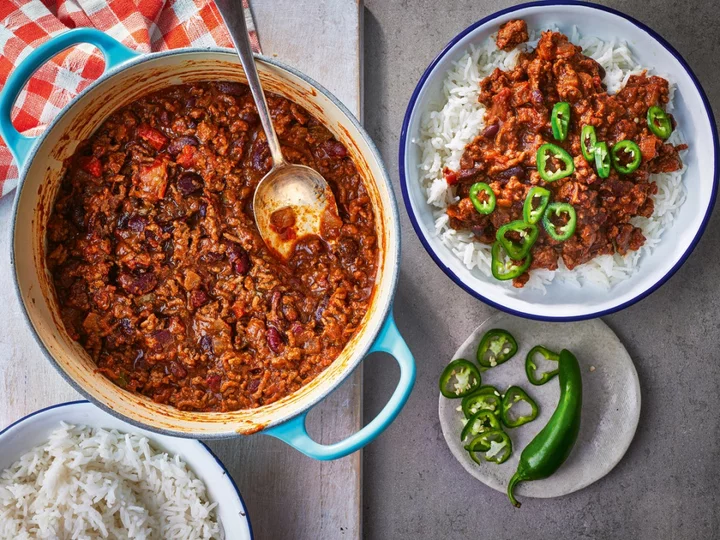
Money-saving chilli con carne that absolutely slaps with flavour
This is a versatile dish that you can pair with many different things; have it with rice, smother it over fries, put it on a hot dog, pour it over a jacket spud or just use it as a dip for tortilla chips,” says Mitch Lane, author of Feed Your Family For Under A Fiver. “It can be frozen as well, so it’s great for saving time while meal prepping! I use store-bought chilli con carne seasoning, but if you have a lot of spices in your cupboard (cumin, chilli powder, paprika, cumin seeds) then you’re on to a winner. This is so simple and it absolutely slaps with flavour.” Chilli con carne Serves: 4 Ingredients: 1 tsp vegetable or olive oil 1 onion, finely chopped 4 garlic cloves, finely chopped 2 green chillies, finely chopped, plus 1 to serve 500g minced beef 41g packet of chilli con carne seasoning 400g tin chopped tomatoes 130g tin kidney beans, drained 300ml beef stock (made with a stock cube) Salt and pepper Method: 1. Put a pan on a medium heat and add the oil and the onion and soften for three to four minutes. Add the garlic and chillies and continue to cook for a further two minutes. If you’re not keen on a lot of spice just use one chilli and remove the seeds. 2. Add the mince and break it up with the back of a spoon, ensuring that there’s no big lumps. Cook the meat until it’s nice and brown. Be generous with the salt and pepper and then add the chilli con carne seasoning. Mix well. 3. Add the tomatoes and kidney beans and stir. Then pour in the beef stock and simmer for 30 minutes. The simmering is very important (it’s like a fine wine that gets better with age). 4. Serve with sliced chilli. ‘Feed Your Family For Under A Fiver’ by Mitch Lane (Thorsons, £16.99). Read More The dish that defines me: Mallini Kannan’s baked honey-soy salmon Breakfast for dinner and four other things you should cook this week How to save money in the kitchen according to top chefs How to pimp up your instant ramen (and save money) Do it for the Gram: Speedy but spectacular goat’s cheese linguine Where to find the best Guinness in London – and how to spot a bad one
2023-08-16 13:56
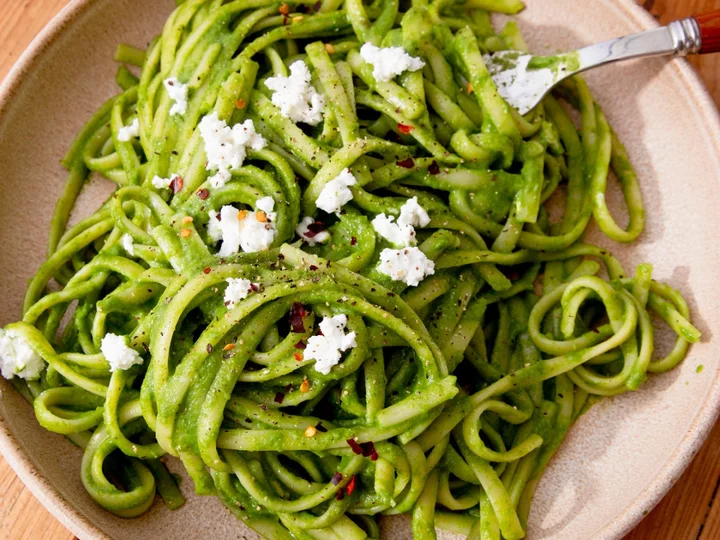
Do it for the Gram: Speedy but spectacular goat’s cheese linguine
This vibrantly green pasta recipe is one of my favourites in the book,” says Mimi Harrison, author of Beat The Budget. “Not only is it bright and Instagrammable, it’s also so delicious. The frozen spinach is reasonably priced and you don’t have to worry about it going off in the fridge. And the goat’s cheese provides creaminess, acidity and tang, all in one ingredient (hello, cost-effective!). “This is ideal for a speedy meal when you’re in a rush, or to serve to friends at a dinner party when you don’t want to spend half the night in the kitchen.” Goat’s cheese, spinach and basil linguine Serves: 5 Ingredients: 1 tbsp olive oil 1 onion, diced 500g linguine 3 garlic cloves, finely grated 160g frozen spinach 125g goat’s cheese 30g fresh basil Salt and pepper to taste Chilli flakes (optional) Method: 1. Set a non-stick pan over a medium heat and add the olive oil. Add the onion, season with salt and pepper and gently fry for four minutes. 2. Meanwhile, set a large pan of salted water over a medium heat and bring to a boil. Add the linguine and cook for two minutes less than the packet cooking time. 3. While the pasta is cooking and once the onions have softened, add the garlic to fry for a minute before adding the frozen spinach to the pan, along with 400 millilitres of the starchy pasta water. Increase the heat and cook the spinach and onion mix until the pasta is ready. 4. Add the spinach and onion mix to a blender with half of the goat’s cheese and the basil and blitz until smooth. 5. Drain the linguine and transfer back to the pan. Pour over the blended sauce and continue to cook over a low\medium heat. 6. After about two minutes, the sauce should thicken and coat the linguine. Serve with a sprinkle of any remaining goat’s cheese and a pinch of salt and pepper. Optionally, top with chilli flakes if you love a little heat. ‘Beat The Budget’ by Mimi Harrison (Ebury Press, £16.99). Read More The dish that defines me: Mallini Kannan’s baked honey-soy salmon Breakfast for dinner and four other things you should cook this week How to save money in the kitchen according to top chefs Money-saving chilli con carne that absolutely slaps with flavour How to pimp up your instant ramen (and save money) Where to find the best Guinness in London – and how to spot a bad one
2023-08-16 13:53
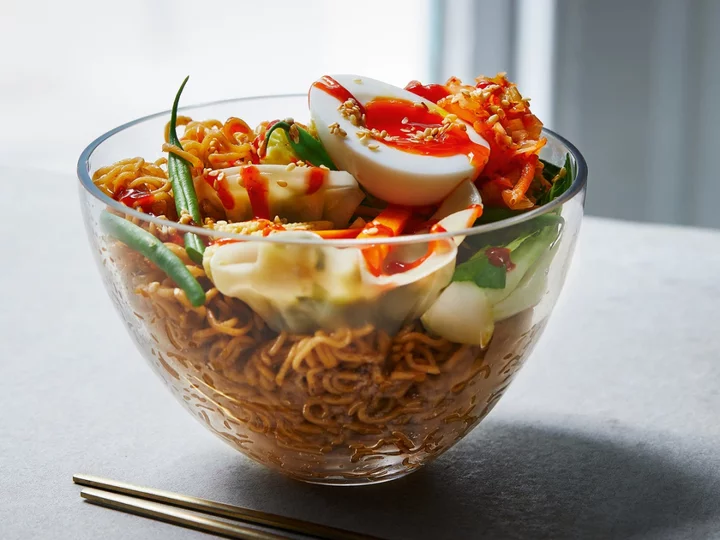
How to pimp up your instant ramen (and save money)
There is something so wonderfully comforting about a bowl of ramen noodles, whatever the season,” says chef and TV presenter Shivi Ramoutar, author of Cook Clever. “This version uses packet ramen – don’t turn your nose up at it; I assure you that with the added flavours, veg and protein, it becomes something spectacular and amazingly easy to accomplish. This is one to elevate to your heart’s content – you really can’t go too OTT with this. Have it slurpy or dry as you like.” Pimped packet ramen Serves: 2 Ingredients: For the base: 2 tbsp toasted sesame oil 1 spring onion (white bulb discarded), snipped 1 tsp garlic purée 2 mugs of boiling water 2 packets of ramen noodles (or any other instant noodles) OR 300g ready cooked noodles and 1 chicken stock cube, crumbled OR 300g ready cooked noodles and 2 sachets of miso soup mix For the protein (choose from): 1 mug of frozen, fresh or cooked chicken strips 1 mug of frozen, fresh or cooked seafood 1 mug of frozen or fresh gyoza dumplings ½ block of firm tofu, broken into smaller pieces For the veg: 250g packet of pak choi, leaves separated ½ mug of frozen vegetables Toppers (choose as many as you like): Soft-boiled egg halves Drizzles of chilli oil 1 tbsp sesame seeds Fresh coriander sprigs Fresh chillies Kimchi Drizzles of sriracha Method: 1. Heat the oil in a small saucepan over a medium heat and cook the spring onion and garlic purée for a couple minutes, stirring often until aromatic. 2. Add the boiling water, along with the dried noodles and their flavour sachets, or the cooked noodles with the crumbled stock cube or the miso soup sachets. Stir together and cook for a minute or two until the liquid is mostly absorbed. 3. Add your chosen protein and the veg and cook until the protein is just cooked through, about five minutes or so. If you are using fresh chicken or seafood it will take less time. If using tofu, add in the last few minutes so it doesn’t disintegrate. 4. Serve into bowls and go crazy with the toppers. ‘Cook Clever: One Chop, No Waste, All Taste’ by Shivi Ramoutar (HarperCollins, £20). Read More The dish that defines me: Mallini Kannan’s baked honey-soy salmon Breakfast for dinner and four other things you should cook this week How to save money in the kitchen according to top chefs Money-saving chilli con carne that absolutely slaps with flavour Do it for the Gram: Speedy but spectacular goat’s cheese linguine Where to find the best Guinness in London – and how to spot a bad one
2023-08-16 13:48
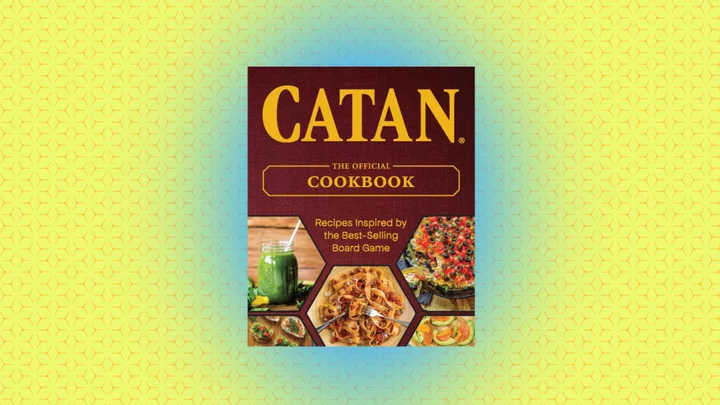
Make Family Game Night Even Better With This New Cookbook Inspired by ‘The Settlers of Catan’
Settle your sweet tooth (and build some alliances in the process) with this all-new cookbook inspired by 'The Settlers of Catan.'
2023-08-16 03:15

Nestlé recalls Toll House cookie dough for potentially containing fragmented wood chips
Nestlé USA is recalling a “limited quantity” of its Toll House Chocolate Chip Cookie Dough “break and bake” after fragmented pieces of wood were found in some packages. On 10 August, the food and drink corporation announced the news in a press release published on its website. According to the company, it had identified two batches of the 16.5 oz product produced on 24 and 25 April as being the reason for the recall, “due to the potential presence of wood fragments”. “This recall does not involve any other Nestlé Toll House products, including other varieties of refrigerated cookie dough in ‘break and bake’ bars, rolls, or tubs, or Edible cookie dough,” the statement read. Nestlé directed consumers’ attention to the recalled batch codes to avoid, both 16.5 oz bags with 311457531K or 311557534K. The company warned people who have already purchased these batches to “not prepare or consume the product” and urged them to “return the product to the retailer where it was purchased for a replacement or refund”. There have been no reported injuries or illnesses related to the recall, according to the confectioners. “We are taking this action out of an abundance of caution after a small number of consumers contacted Nestlé USA about this issue,” the release proclaimed. “The quality, safety and integrity of our products remain our number one priority. We sincerely apologise for any inconvenience this action represents to both our consumers and retail customers.” Nestlé also said it is in contact with the US Drug and Food Administration (FDA) about the recall, according to their press release. Anyone in need of support or with any further questions is encouraged to contact the company’s customer service line at (800) 681-1678 Monday through Friday, between 9am and 6pm ET. The recall comes after Nestlé voluntarily recalled its Stuffed Chocolate Chip Cookie Dough with Fudge Filling because of the “potential presence of white plastic pieces” in October of 2022. The Independent has contacted Nestlé for further comment. Read More Advocates sue federal government for failing to ban imports of cocoa harvested by children Sugary cereals and yoghurts must remove child-friendly packaging – health group Nestle reveals reason behind price increase of its most popular chocolate bar
2023-08-16 00:24

Chloe Bailey brought to tears after hotel ‘serves her meat by accident’
Chloe Bailey was left in distress after she recently accidentally ate a beef burger, interrupting 10 years of dedicated veganism. The singer, 25, and her younger sister Halle Bailey, 23, have both been vegans for the last decade and have been outspoken about their dietary choices. However, Chloe revealed in an Instagram Live stream that she was mistakenly served red meat instead of a plant-based Beyond Meat burger over the weekend, just before attending Beyoncé’s Renaissance World Tour concert in Atlanta, Georgia. According to Chloe, the incident occurred on Saturday (12 August) after she ordered burgers for her and Halle in the hotel they were staying in before the show. She told fans: “So I called to get a Beyond Burger for sis and I like usual. Specified that it’s vegan, no butter on the bun, nothing like that. “So we get the burgers, I’m getting out of the shower… and she’s eating the burger and she’s like, ‘Are you sure this is Beyond?’” Confident in her ordering, Chloe said it was. However, when she took a bite of the burger herself, she realised something was wrong. The “Do It” singer continued: “I touched the patty and smelled it and was like, ‘Of course it’s Beyond, yeah’. So I finish getting dressed, I take a bite and the juice dripping from the burger is not like a Beyond burger. I just knew it was not a fake burger. “The one bite I took and I just knew. Immediately I said, ‘This doesn’t feel right’.” She quickly rang the hotel’s front desk to ask if they delivered vegan burgers to her hotel room. However, the concierge’s answer horrified her. “He said, ‘No, they’re brand burgers’. I said, ‘Brand burgers? I said Beyond burgers’. I don’t even know what a brand burger is,” she told fans on the livestream. “Immediately I’m losing my s***. I gobbled down a whole can of Sprite. Halle’s laughing at me because I’m crying. This is right before the concert yesterday. I’m crying, Halle’s just laughing so hard at me because I’m freaking out. “I’ve been vegan for 10 years. I have not consumed any red meat for 10 years,” Chloe added. The clip was shared on the celebrity news Instagram account The Shade Room, and prompted sympathy from other vegetarian and vegan fans. “I’m vegetarian and it’s definitely hard to tell the difference sometimes but you know the taste of real meat and that stomach ache ain’t no joke,” one person commented. Another said: “My first time eating meat after a full vegan diet, my stomach… revolted.” Halle said in a 2017 interview with Complex that the sisters went vegan because of their mother. She explained: “One day, she was like, ‘I’m gonna try to be vegetarian for a week. You can join me if you’d like’. We started the week with her and just never went back.” In an awkward red carpet exchange at the premiere of live-action remake of The Little Mermaid, Halle was asked who she would choose to eat between Flounder and Sebastian. In the film, Flounder is a fish and Sebastian is a crab. She responded: “I would not eat either of them. They’re my friends." Read More The millionaire smuggled out of Japan in a box: Was Nissan boss Carlos Ghosn a victim or a villain? Husband ‘ruins’ dinner because of his wife’s typo: ‘The worst kind of control freak’ Billy Porter hits out at Harry Styles and Anna Wintour over Vogue cover: ‘You’re using my community’ Foodies forced to eat their own words after trick ‘gourmet’ meal Michelin-starred chef Michael O’Hare puts Skittle twist on classic desserts The dish that defines me: Mallini Kannan’s baked honey-soy salmon
2023-08-15 17:21

The dish that defines me: Mallini Kannan’s baked honey-soy salmon
Defining Dishes is a new Indyeats column that explores the significance of food at key moments in our lives. From recipes that have been passed down for generations, to flavours that hold a special place in our hearts, food shapes every part of our lives in ways we might not have ever imagined. I came up with this baked honey-soy salmon dish in the first flat I ever had all to myself, as a master’s student in Stirling, Scotland. I think that’s what makes me feel most proud of it, because it was the first thing I made that made me truly feel like an adult. I was 25 and had been living away from home in Malaysia for nearly five years, and although I never really cooked with fish, I was really craving it, particularly Chinese steamed fish. Salmon was relatively cheap in Scotland, but I always felt that there was something about cooking fish that was very intimidating. It felt like it was too fancy for me. I also feel like it’s still socially acceptable to eat overcooked, dry chicken breast, but eating overcooked fish is just much more unpleasant and no one wants that. But something came over me one day when I saw a fresh salmon fillet with a really good discount in the Tesco clearance aisle. Maybe that should tell you something about me – I don’t know if others would consider that safe – but it looked good and I said, “You know what, maybe today’s the day”. At the time, it so happened that honey-soy salmon was really trending, I had seen it all over the place. I didn’t Google a recipe, I just sort of figured out what flavours could be good on a piece of fish. I made a sauce using soy sauce, Chinese cooking wine and maple syrup (which was gifted to me by one of my very nice friends), poured it on top of the fish and shoved it in the oven, because I didn’t have a steamer then. I did look up how long to cook it for, and Google said 20 minutes. I ate it with steamed rice and to my delight, surprise and relief, it was absolutely delicious. I felt really good about it. It was a real level-up moment in my life. It was the first time I had made a difficult dish, even though the actual labour wasn’t difficult at all and it is essentially a very simple dish. It made me feel like I could do it; I could make grown-up food. At the time, I was 24 or 25-years-old and I had been living away from home for some time, but never without housemates. So I was truly on my own. It was a revelation to realise that I could make Chinese food like this at home. I come from a Malaysian-Indian family. We don’t steam much of anything and so if I wanted steamed fish, I’d have to go to a Chinese restaurant. But now, I didn’t really have to. After that, it became my hyper-fixation meal. I just couldn’t get enough of it and made it all the time – at the peak of my fixation, I ate it three times a week. But I did learn that it does not make for good leftovers. It must be eaten on the day it’s made, otherwise the fishy smell gets a bit unappealing. Once I learned that, I ate it about once a week, and each time I’d experiment with it. I learned the importance of adding aromatics like garlic, ginger, spring onions, coriander and chili. But the key motivator to my experiments was laziness. Could I get away with not slicing things up? What if I don’t want to turn the stove on? How can I cut corners? No matter what kind of nonsense I threw at it, it has always turned out reliably good. The first time I cooked the dish for someone else was when my parents came to visit me from Malaysia. We had just returned from a trip, and they were staying in my flat for a week and it was the first time they came to a place that was truly mine. I remember very clearly cooking the salmon for them because a couple of friends had invited me out to the pub that night and I wanted to go, but I didn’t want to order takeaway for my parents – they were at that stage in their holiday when all Asian parents get grumpy because they haven’t had rice in three days and it was paramount that they ate some immediately. I had 30 minutes before I had to get going to the pub, and I figured that I knew how to cook this dish so well by now that I could get it done in 20 minutes. However, it was also the first time I had scaled a fish. Before, I just cooked the fish with scales and all, I didn’t even realise you had to take them off. For some reason, this time I decided I needed to scale this slab of salmon. I read one Google-recommended article and was like: “Let’s go.” What they don’t tell you is that scales fly. They go absolutely everywhere. And there’s a kind of black coating, like a slime, on the fish that will also go everywhere. I remember my parents peeking their head around the kitchen door to ask if everything was OK, and me just barking: “YA IT’S FINE.” I had to get that thing in the oven NOW, so it had to happen. And you know what? It turned out great. This was the second dish I’ve made for my parents that they’ve said: “Oh, wow.” The first time was for a prawn curry, but this was special because they were so impressed by the efficiency of it and also, it was the first time they realised that wow, I’m an adult, I’ve figured it out. They were used to me making good food, but this was the first practical dish; it’s not me sitting in the kitchen, having to cut a mountain of onions and pounding galangal. Last year, after I moved to Virginia to be with my husband, I made it for him for the first time. It feels really nice to share this part of me with him. It was a piece of myself that I figured out on my own, before married life, and it feels really significant because it was my independence dish. I want everybody to make it. However, I have a bone to pick with fishmongers in the UK. I want to know why they don’t scale the fish you buy unless they’re asked. Surely nobody wants to eat the scales? Just scale it please, thank you very much. And if any readers have suggestions for how I can make my baked salmon skin crispy, I would very much like to know. I still haven’t figured that part out yet. Mallini Kannan is a communications specialist from Malaysia, who now lives in the US with her husband. She still cooks this dish every week. Read More The dish that defines me: Frank Yeung’s prawn wontons The dish that defines me: Alex Outhwaite’s Vietnamese bun cha The dish that defines me: Eddie Huang’s Taiwanese beef noodle soup Breakfast for dinner and four other things you should cook this week Where to find the best Guinness in London – and how to spot a bad one How sizzling kitchen drama The Bear is spicing up the dating game for chefs
2023-08-15 13:50

The World's Oldest Restaurant Has Been Operating Continuously for 300 Years
Many elements of Restaurante Botín in Madrid date back to when it opened in 1725, including the fire in the oven.
2023-08-15 04:16
You Might Like...
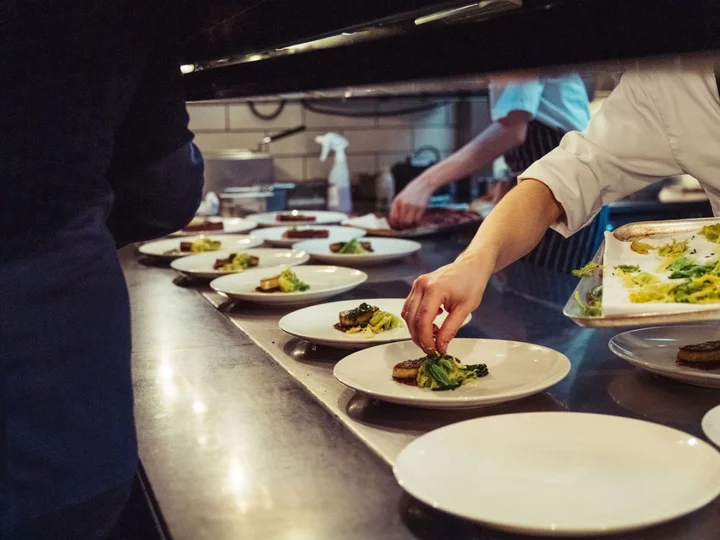
London’s best new restaurants: From Spanish-Welsh fusion at Mountain to British kitsch at 20 Berkeley
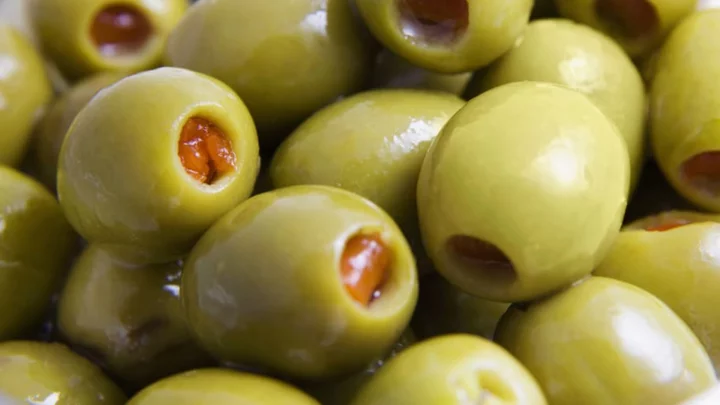
What Are Pimentos, And How Do They Get Inside Olives?

Does turkey really make you tired? Chefs share the best time to host Thanksgiving dinner

DoorDash, Grubhub, Uber Eats can sue NYC over commission caps

Hong Kong poised to ban Japanese seafood over treated nuclear wastewater

Gear Up for Game Day With These 15 Must-Have Tailgating Essentials

20 of the Best Pumpkin Spice Products to Satisfy Your Autumnal Obsession

I feel it in my fingers: Why more of us should start eating with our hands
